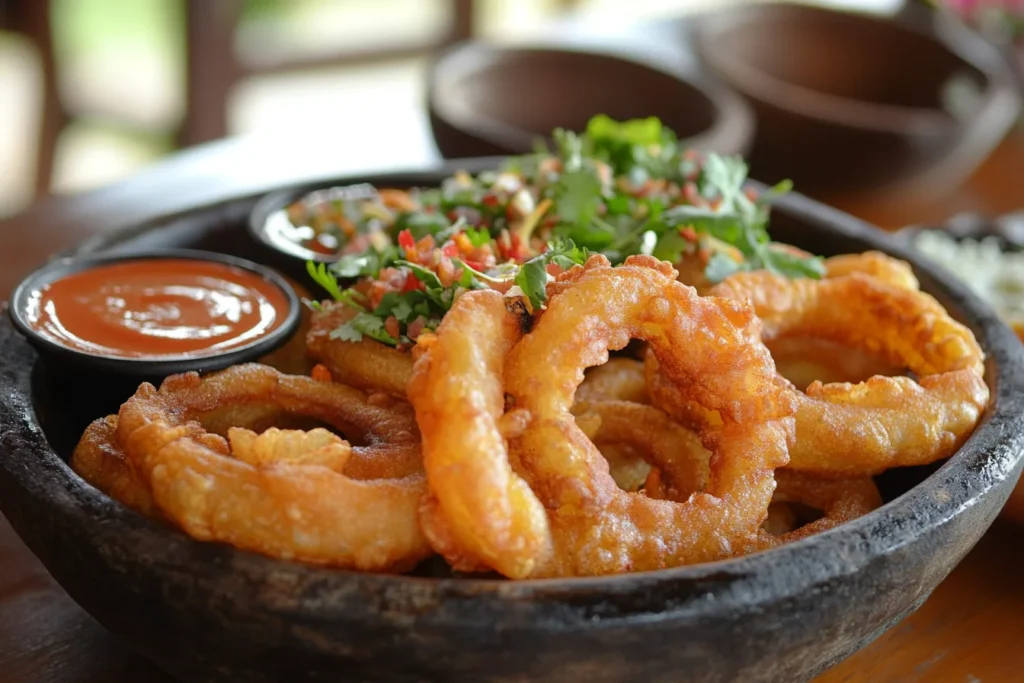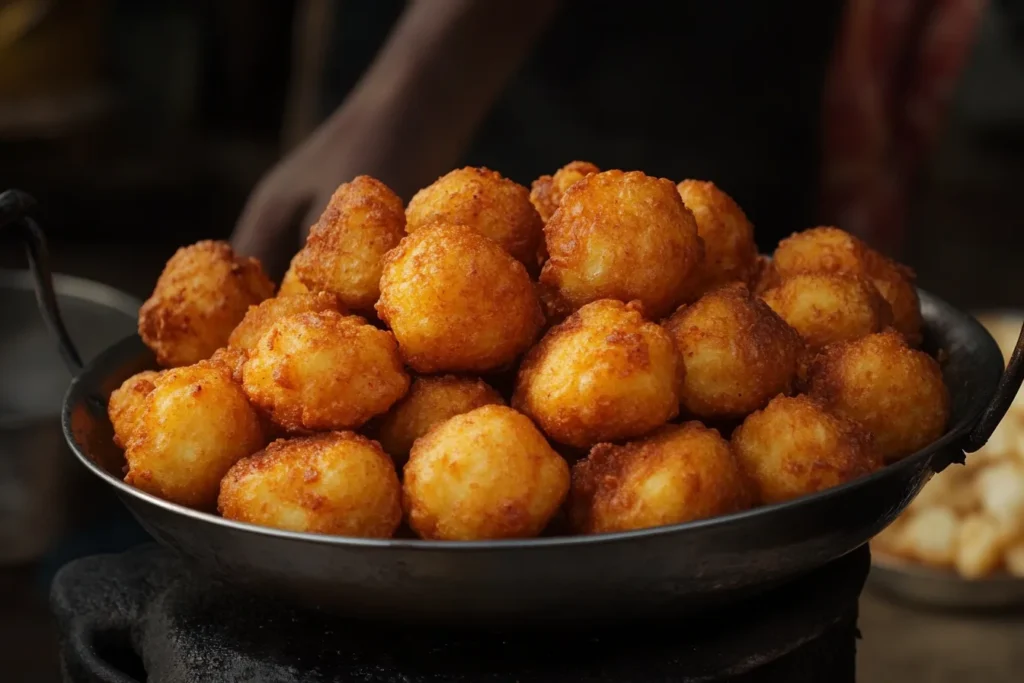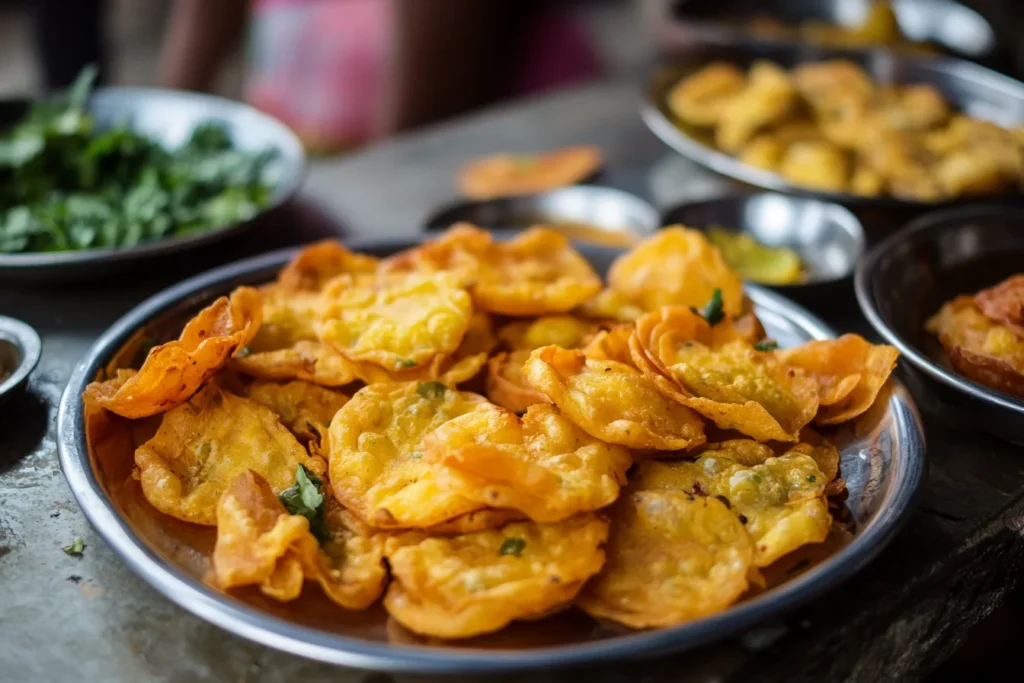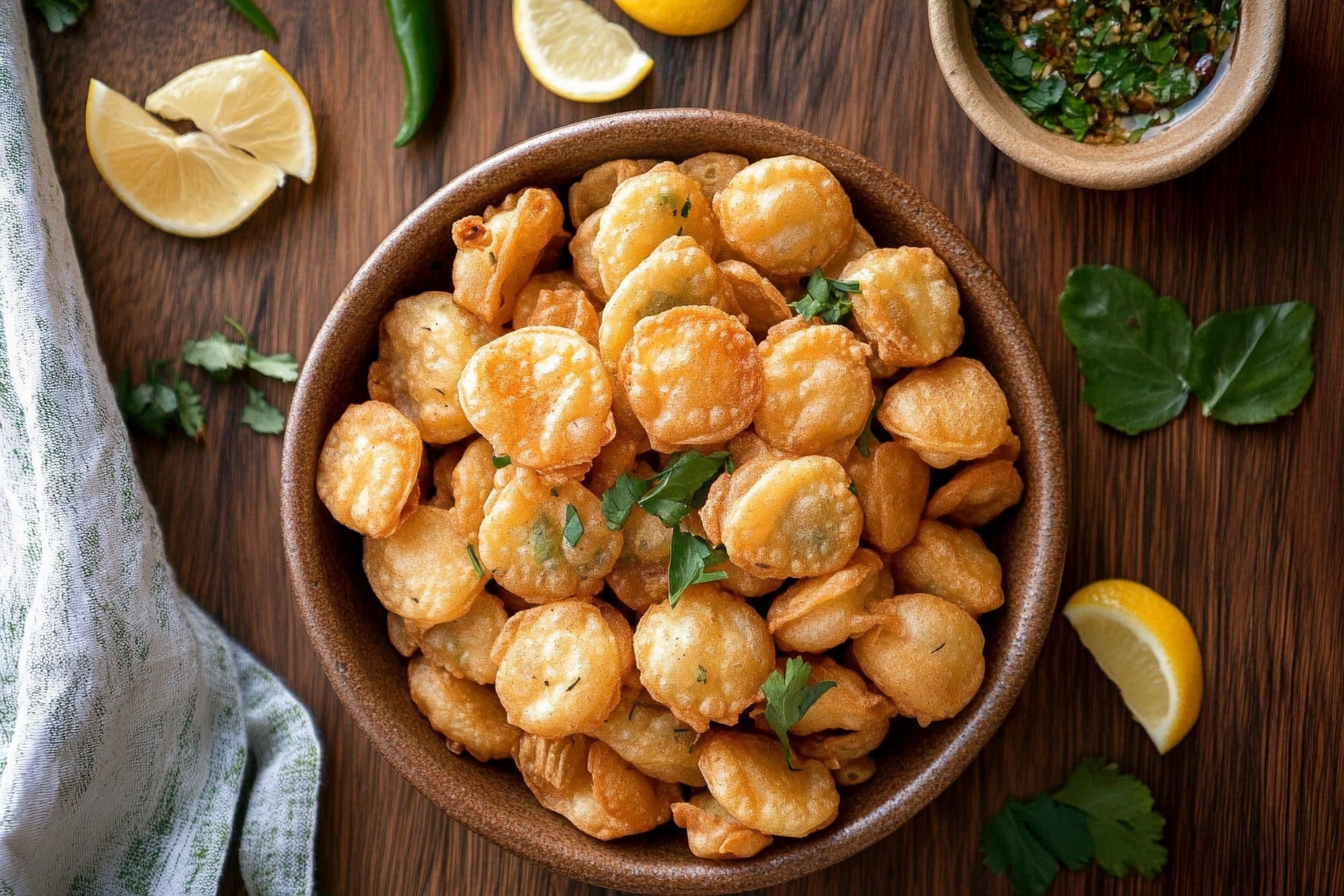Bhajiya, a beloved Indian snack, is a testament to the country’s rich culinary heritage. This crispy, golden delight has not only satisfied countless hunger pangs but also brought people together over tea and conversations. Whether you know it as Pakora, Bhaji, or by one of its many regional names, Bhajiya is more than just food – it’s a cultural phenomenon. Let’s explore its fascinating history, diverse types, and irresistible allure.

H1: Introduction to Bhajiya
Bhajiya is an iconic Indian fried snack, primarily made from gram flour batter and various vegetables. This simple yet delicious dish has gained immense popularity due to its versatility and ease of preparation. You’ll find it served as a roadside snack, a party appetizer, or a homely treat. With its crunchy exterior and flavorful core, Bhajiya is a staple in Indian households.
From piping hot Onion Bhajiya to the spicy Mirchi Bhajiya, each bite tells a story of tradition and flavor. It’s a dish that bridges the gap between regions, bringing unique twists and ingredients to a common culinary canvas.
H2: Historical Significance
The origins of Bhajiya date back to ancient India, where deep-fried delicacies were often prepared during celebrations and festivals. Its roots lie in Indian Ayurveda, which encouraged using gram flour for its health benefits. Over time, this dish evolved, adapting to local tastes and becoming a versatile snack that appealed to all social strata.
Bhajiya’s cultural importance cannot be overstated. From being served in royal feasts to becoming a street food staple, it has traversed centuries and social contexts, firmly embedding itself in Indian culinary culture.
H3: What is Bhajiya Indian fried snack Made Of?
The heart of any good Bhajiya lies in its ingredients, which are both simple and wholesome. Here’s a breakdown of the essentials:
- Gram Flour (Besan): Forms the base of the batter and adds a nutty flavor.
- Vegetables: From potatoes to onions, these provide texture and taste.
- Spices: Turmeric, chili powder, and carom seeds enhance the flavor.
- Water: Used to create the perfect batter consistency.
- Oil: For deep-frying, ensuring that crispy golden crust.
Each ingredient plays a role in achieving the perfect texture and flavor balance.
H4: Common Types of Bhajiya Indian fried snack
Bhajiya is a highly versatile snack with numerous variations across India. Some popular types include:
- Onion Bhajiya: Made with thinly sliced onions for a crunchy, savory bite.
- Potato Bhajiya: Soft on the inside, crispy on the outside.
- Palak (Spinach) Bhajiya: A healthy twist using nutrient-rich spinach.
- Mirchi (Chili) Bhajiya: For those who love a spicy kick.
- Bread Bhajiya: A creative variation using slices of bread.
Each type brings its own unique flavor profile to the table.
H5: Regional Names for Bhajiya Indian fried snackWhile Bhajiya is universally loved, it goes by different names across India. Here’s a quick look:
- Pakora: Common in North India.
- Bhaji: Widely used in Maharashtra.
- Fritters: English-speaking regions often refer to them this way.
- Bajji: Popular in South India.
These regional nuances add depth to Bhajiya’s cultural richness.
H6: The Allure of Bhajiya Indian fried snack
Why are fried snacks like Bhajiya so irresistible? It boils down to:
- Texture: The crunch of the outer layer contrasts beautifully with the soft filling.
- Aroma: The combination of spices and frying creates an enticing scent.
- Convenience: Quick to prepare and easy to serve.
- Versatility: Works as a snack, appetizer, or even a side dish.
This culinary experience makes Bhajiya a favorite for all ages.
H7: Textures and Flavors of Bhajiya
The perfect Bhajiya is a harmony of textures and flavors:
- Crispy Exterior: Achieved through the right frying technique and batter consistency.
- Soft and Juicy Interior: Ensuring the vegetable filling retains moisture.
- Flavorful Spices: A blend of spices enhances the overall taste.
Balancing these elements is key to creating a Bhajiya that stands out.
H8: Bhajiya vs. Pakora: What’s the Difference?
Many people use Bhajiya and Pakora interchangeably, but subtle differences exist:
- Bhajiya: Typically made with finely chopped or grated vegetables.
- Pakora: Larger pieces of vegetables are dipped in batter.
- Regional Influence: Pakora is more common in North India, while Bhajiya is a term favored in the West and South.
Both, however, share the same delicious essence.
H9: Popular Occasions for Bhajiya
Bhajiya is enjoyed across a variety of occasions, such as:
- Rainy Days: Perfect comfort food during monsoon.
- Festivals: Served as part of celebratory meals.
- Parties: A popular appetizer at gatherings.
- Street Snacks: Found at roadside stalls and bustling markets.
Its versatility makes it an all-season favorite.
H10: Why Bhajiya Is Comfort Food
Bhajiya holds a special place in the hearts of many as a comfort food. Here’s why:
- Nostalgia: Reminds people of childhood and family moments.
- Warmth: Served hot, it provides a sense of coziness.
- Flavor: The spices and fried aroma evoke happy emotions.
Whether paired with tea or enjoyed alone, Bhajiya is a dish that soothes the soul.

Part 2: Ingredients and Preparation of Bhajiya
Bhajiya’s universal appeal lies not only in its taste but also in its simplicity. The ingredients are easy to source, and the preparation process is straightforward, making it an accessible dish for everyone. In this section, we will explore the key ingredients, preparation techniques, and modern adaptations that elevate this humble snack into a culinary delight.
H1: Key Ingredients in Bhajiya
The foundation of a perfect Bhajiya starts with the right ingredients. Here are the essentials:
- Gram Flour (Besan):
- The primary ingredient that forms the batter.
- Known for its nutty flavor and gluten-free properties.
- Vegetables:
- Popular choices include onions, potatoes, spinach, and chilies.
- Seasonal vegetables like pumpkin or zucchini add variety.
- Spices:
- Turmeric, red chili powder, and cumin enhance flavor.
- Carom seeds (ajwain) aid digestion and add a unique aroma.
- Water:
- Used to create a smooth and lump-free batter.
- Cooking Oil:
- Essential for deep-frying and achieving the desired crispiness.
Together, these ingredients create the foundation for Bhajiya’s irresistible texture and flavor.
H2: Gram Flour: The Star Ingredient
Why is gram flour indispensable in making Bhajiya?
- Texture: Its fine consistency creates a smooth batter that coats vegetables evenly.
- Flavor: Adds a subtle nuttiness that complements spices and vegetables.
- Health Benefits: Rich in protein and fiber, gram flour is a healthier alternative to regular wheat flour.
Its versatility extends beyond Bhajiya Indian fried snack, being used in other Indian dishes like dhokla and kadhi. For the perfect Bhajiya, using fresh and finely ground gram flour is key.
H3: Vegetables Commonly Used in Bhajiya Indian fried snack
The choice of vegetables can transform the flavor profile of Bhajiya. Here are some popular options:
- Onions: Thinly sliced for a crunchy texture.
- Potatoes: Sliced or grated for a starchy, filling base.
- Spinach: Adds a nutritious and earthy flavor.
- Chilies: Whole or sliced for a spicy kick.
- Eggplant (Brinjal): Soft and creamy after frying.
Pro Tip: Using fresh, seasonal vegetables not only enhances flavor but also adds a regional touch to your Bhajiya.
H4: Importance of Spices in Bhajiya Indian fried snack
Spices are the soul of Bhajiya, transforming it from ordinary to extraordinary. Here’s how they play a role:
- Turmeric: Provides a golden color and earthy flavor.
- Red Chili Powder: Adds heat and depth.
- Cumin and Coriander: Bring a savory aroma.
- Carom Seeds: Help in digestion and add a distinct flavor.
Spices allow customization, catering to both mild and spicy palates.
H5: Traditional Preparation Methods
Making Bhajiya the traditional way is an art. Follow these steps for authentic results:
- Prepare the Batter:
- Combine gram flour, spices, and water to create a thick yet pourable batter.
- Whisk until smooth to incorporate air, which adds fluffiness.
- Prep the Vegetables:
- Slice or chop vegetables uniformly for even cooking.
- Pat them dry to ensure the batter sticks well.
- Heat the Oil:
- Use medium heat to ensure the Bhajiya cooks evenly.
- Fry the Bhajiya:
- Dip the vegetables in batter and gently slide them into hot oil.
- Fry until golden brown and crisp.
- Drain Excess Oil:
- Use a paper towel or wire rack to remove excess oil before serving.
This step-by-step process guarantees perfectly crispy Bhajiya every time.
H6: Modern Twists on Bhajiya
Innovation has brought new dimensions to this traditional snack. Here are some creative twists:
- Cheese Bhajiya: Adding grated cheese to the batter for a gooey surprise.
- Chocolate Bhajiya: A sweet version for dessert lovers.
- Quinoa Bhajiya: A healthy, high-protein variation.
- Stuffed Bhajiya: Filling chilies or potatoes with spiced mixtures before frying.
These adaptations showcase Bhajiya’s versatility and its ability to evolve with modern trends.
H7: Bhajiya Batter: The Secret to Success
Achieving the perfect batter consistency is crucial. Here’s what to keep in mind:
- Consistency: The batter should coat the back of a spoon without dripping excessively.
- Whisking: Incorporate air by whisking vigorously, which ensures lightness.
- Seasoning: Always taste and adjust salt and spices before frying.
A well-prepared batter is the foundation of crispy and flavorful Bhajiya.
H8: Deep-Frying Techniques for Bhajiya
Mastering the art of deep-frying is essential for Bhajiya. Follow these tips:
- Oil Temperature: Maintain medium heat; too hot will burn the Bhajiya, while too low will make them soggy.
- Batch Size: Fry in small batches to avoid overcrowding, ensuring even cooking.
- Draining: Use a slotted spoon to remove Bhajiya and drain excess oil.
Perfect frying results in Bhajiya that are crisp on the outside and tender on the inside.
H9: Pairing Bhajiya with Chutneys
No Bhajiya is complete without its perfect accompaniments. Here are some popular chutneys:
- Mint Chutney: Refreshing and tangy.
- Tamarind Chutney: Sweet and sour, balancing the richness of fried Bhajiya.
- Garlic Chutney: Spicy and bold, for those who love heat.
- Tomato Sauce: A modern, kid-friendly option.
These dips elevate the flavors of Bhajiya, making them even more irresistible.
H10: Gluten-Free and Vegan Variations
For those with dietary restrictions, Bhajiya can easily be adapted:
- Gluten-Free: Replace gram flour with chickpea flour or a gluten-free flour blend.
- Vegan: Bhajiya is naturally vegan as it uses no animal products.
By customizing ingredients, you can enjoy this snack guilt-free while adhering to specific diets.

Part 3: Popular Bhajiya Variants
Bhajiya is a dish of endless variety, with each region and household having its own unique take. From spicy to mild, and from simple to elaborate, the versatility of Bhajiya ensures there’s a version for everyone. In this section, we will explore popular variants, seasonal options, and even its international appeal.
H1: Onion Bhajiya: A Classic Favorite
Onion Bhajiya is arguably the most popular variant. The combination of crispy onions and spiced batter creates a universally loved snack. Here’s how to perfect it:
- Thin Slices: Slice onions thinly for even frying and a crisp texture.
- Seasoning: Add a pinch of turmeric, chili powder, and ajwain to the batter.
- Frying Tip: Drop small clusters of batter-coated onions into the oil.
Pro Tip: Pair Onion Bhajiya with tangy tamarind chutney for an explosion of flavors.
H2: Potato Bhajiya: A Filling Delight
Potato Bhajiya is the ultimate comfort food. Soft and starchy inside, with a crisp outer layer, this variant is a favorite across India. Here’s how to make it right:
- Slice or Grate: For variety, use thin slices for crispy Bhajiya or grated potatoes for a denser version.
- Season Generously: Add a touch of black salt and chat masala for extra flavor.
- Frying Technique: Fry until the edges turn golden brown for the perfect texture.
Potato Bhajiya is best served with mint chutney or ketchup, making it an all-time crowd-pleaser.
H3: Palak (Spinach) Bhajiya
For a healthy twist, Palak Bhajiya combines the nutritional goodness of spinach with the rich flavors of fried batter. Key tips include:
- Fresh Leaves: Use whole spinach leaves or chop them for a more uniform texture.
- Batter Prep: Add extra cumin seeds for a savory touch.
- Crunch Factor: Ensure the spinach is dry before dipping into the batter for a crispy finish.
Palak Bhajiya is ideal for serving as a side dish or a tea-time snack.
H4: Mirchi (Chili) Bhajiya
Mirchi Bhajiya is for spice enthusiasts who love bold flavors. Large, mildly spiced green chilies are the star ingredient. Preparation tips:
- De-seeding: For a milder taste, remove the seeds before coating in batter.
- Stuffing: Add a mixture of spiced mashed potatoes or paneer to balance the heat.
- Frying: Ensure the chili is cooked through but retains its crunch.
This fiery snack pairs perfectly with cooling curd-based chutneys.
H5: Bread Bhajiya: A Unique Twist
Bread Bhajiya offers a creative spin on the classic. It’s particularly popular for its quick preparation and filling nature. How to make it:
- Bread Prep: Use day-old bread for better absorption.
- Batter Tips: Add a dash of garam masala for extra flavor.
- Frying Technique: Cut bread slices into small triangles for even frying.
Bread Bhajiya is perfect for kids and adults alike, especially when paired with tomato ketchup.
H6: Mixed Vegetable Bhajiya
Why settle for one vegetable when you can have a medley? Mixed Vegetable Bhajiya combines different textures and flavors into one snack. Ingredients typically include:
- Vegetable Options: Carrots, beans, cauliflower, and bell peppers.
- Chopping Style: Ensure uniform sizes for even frying.
- Flavor Boost: Add a touch of coriander and green chilies for freshness.
Mixed Vegetable Bhajiya is a great way to use up leftover veggies while creating a delightful snack.
H7: Seasonal Bhajiya Options
The beauty of Bhajiya lies in its adaptability to seasonal produce. Examples include:
- Winter: Cauliflower Bhajiya or sweet potato Bhajiya.
- Monsoon: Onion and chili Bhajiya for rainy-day indulgence.
- Summer: Bottle gourd (lauki) Bhajiya for a lighter option.
Using fresh, seasonal ingredients not only enhances flavor but also ensures the snack is packed with nutrients.
H8: Bhajiya in Festivals and Celebrations
Bhajiya plays a significant role in Indian festivals and celebrations. Its quick preparation and universal appeal make it a staple during:
- Diwali: Served as part of festive feasts.
- Holi: Accompanied by sweet drinks like thandai.
- Ramadan: Often enjoyed during iftar as a filling snack.
Its versatility ensures Bhajiya is always a part of joyous occasions.
H9: Street Food Bhajiya
The street-style Bhajiya experience is unparalleled. Here’s how it differs from homemade versions:
- Crispier Texture: Achieved using high heat and special batter techniques.
- Bold Spices: Street vendors often add extra spices and herbs.
- Serving Style: Typically served in newspaper cones with tangy chutneys.
Street-style Bhajiya captures the essence of India’s vibrant food culture.
H10: International Takes on Bhajiya
While Bhajiya is uniquely Indian, its concept finds parallels in global cuisines:
- Tempura (Japan): Similar to Bhajiya but with a lighter batter.
- Fritters (Western Cuisine): Often made with sweet corn or zucchini.
- Pakoras (Pakistan): A close cousin of Bhajiya with regional variations.
These international adaptations highlight the universal appeal of fried snacks.
More FAQs About Bhajiya
- Can I make Bhajiya without deep-frying?
Yes, you can bake or air-fry Bhajiya for a healthier version. - Why is my Bhajiya not crispy?
Ensure the oil is at the right temperature and avoid overcrowding the pan. - Can I freeze Bhajiya batter?
It’s best to use the batter fresh, but it can be refrigerated for up to 24 hours. - What oil is best for frying Bhajiya?
Use oils with a high smoke point, such as sunflower or peanut oil. - Is Bhajiya gluten-free?
Traditional Bhajiya is gluten-free when made with gram flour. - How do I prevent Bhajiya from absorbing too much oil?
Maintain the oil at medium-high heat and drain on paper towels. - Can I add eggs to Bhajiya batter?
While traditional recipes don’t include eggs, you can add them for extra fluffiness. - What’s the best way to serve Bhajiya?
Serve hot with chutneys and a steaming cup of tea. - Can I make Bhajiya spicy?
Adjust the spice level by increasing chili powder or adding green chilies. - Is Bhajiya vegan?
Yes, it is naturally vegan as it contains no animal products.

